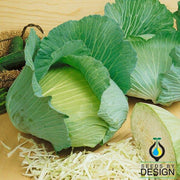DESCRIPTION
Growing Late Flat Dutch Cabbage Garden Seeds
Growing Directions:
The Late Flat Dutch variety of cabbage does well when it is first sown indoors, and then transplanted between 5 and 7 weeks later, after the final frost of the winter season. When looking for a spot in the garden to transplant seedlings, it is important to find an area with full sunlight and composted, moist soil. This will require consistent watering of the plants, around two inches of water each week. The process of transplanting the seedling will be the most successful if they are hardened off throughout the course of a week or ten-day period. Cover each seedling with half an inch of soil at the base. To allow them to grow to their full potential, keep one and a half feet between plants with two feet between rows. When the heads are firm, they are ready to be harvested. For this variety, this will happen at around 100 days of maturity. Remove the entire plant when harvesting heads, including the stem and root, for healthy soil.
Facts:
These pale green leaves have a sweet delicious crunch, and nutritional benefits, making them a great choice for the home garden!
ATTRIBUTES
Basic Info
| Latin Name: |
brassica oleracea var. capitata |
| Color: |
Pale green |
| Flavor: |
Subtle, crisp and sweet |
Growing Info
| Days to Maturity: |
70-80 days |
| Hardiness Zone: |
1-10 |
| Planting Depth: |
¼-½" |
| Plant Spacing: |
1-2 Inches |
| Row Spacing: |
2 Inches |
| Growth Habit: |
Upright |
| Soil Preference: |
Moist, composted soil |
| Temp Preference: |
Warmer |
| Light Preference: |
full to partial sun |






